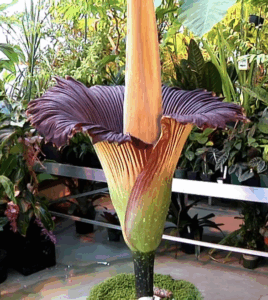The giant corpse flower is currently blooming. Free public viewing is available on Wednesday, July 16, until 9 p.m. in the Augsburg University Greenhouse.
The greenhouse is located on the fourth floor of the Hagfors Center (700 21st Ave S, Minneapolis). It is accessible via stairs or the elevator at the north end of the building.
For those who are unable to visit in person, a livestream is available.
The hot, sweaty weather of July has brought a truly extraordinary botanical curiosity out of dormancy. The giant corpse flower, or titan arum (Amorphophallus titanum), is famous for producing an enormous, sinister, powerfully malodorous, but thankfully short-lived bloom. At 94 inches tall as of July 14, Augsburg University’s very own corpse flower is getting ready to put on its first floral display.
The plant has tentatively been dubbed “Lady Gag-Ugh,” in reference to the formidably foul smell―reminiscent of roadkill―it produces once open. The corpse flower will unfurl its bloom and emit its foul stench for a mere 24–36 hours before rapidly collapsing back into dormancy.
Augsburg University obtained its specimen as a donation from the United States Botanic Garden in Washington, D.C. It forms part of an ongoing series of projects by biology professor Leon van Eck, curator of the Augsburg Greenhouse, to increase the diversity and conservation value of the permanent plant collection at Augsburg. “Lady Gag-Ugh” was grown from seed sown at USBG in February 2018, in D.C. The plant has been growing at Augsburg since July 2021, and is now flowering for the first time, at the age of seven.
Giant corpse flowers do not flower very often, and can hold out for almost a decade to do so. Every year or so, the plant sends up a single leaf―at 12 ft tall bigger than some small trees―to convert sunlight energy into sugars that get stockpiled in a large underground stem called a corm. Once the corm has enough energy stored up, the corpse flower will finally transition to reproductive mode and send up a flower stalk. “Lady Gag-Ugh” has now done exactly that.
These precious rainforest divas are temperamental, and the exact moment of blooming is difficult to predict. As of July 14, van Eck estimates the blooming of “Lady Gag-Ugh” between July 15–18. Once unfurled, the bloom will rapidly burn energy to heat up its central spire and emit its putrid scent, aiming to attract carrion beetles and flesh flies as pollinators.
This tropical relative of the jack-in-the-pulpit is native to the island of Sumatra in Indonesia. In the wild, there are fewer than 1,000 mature individuals of this species remaining, and its continued survival is threatened by habitat loss to expanding oil palm plantations. Displays of these rare corpse flowers at botanic gardens and conservatories around the world attract thousands of visitors annually, and Augsburg is proud to continue the practice of preserving and exhibiting this rare and remarkable species.
The corpse flower is located in the greenhouse on the 4th floor of Hagfors Center at 700 21st Ave S in Minneapolis; arrangements are underway for free public viewing until 9 p.m. on the day it flowers. Follow @augsburg_greenhouse on Instagram for updates and more details.

